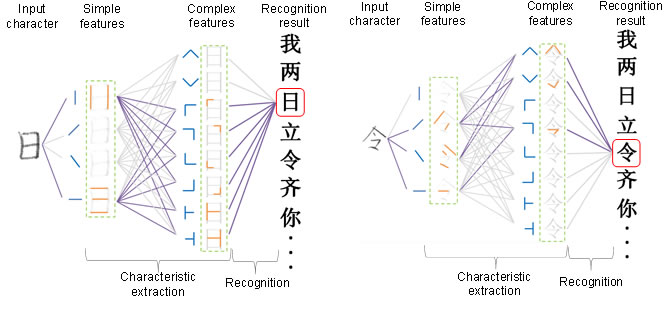Beijing, China, and Kawasaki, Japan, August 21, 2013 — Fujitsu Research and Development Center Co., Ltd. and Fujitsu Laboratories Ltd. today announced development of industry’s most accurate handwritten character recognition technology that employs artificial intelligence (AI) to mimic the workings of the human brain.
Conventional handwritten character recognition attempts to identify a character based on the number and angle of its strokes. Severely misshapen characters, however, might not be recognized using this method, and increasing recognition accuracy requires the character to be “learned” in a time-consuming process. This new technology uses AI to recognize character features, in the same way a human brain does, to learn more quickly and in greater detail. This slashes character learning time to 1/17th previous levels while achieving recognition accuracy of 94.8%.
This technology came in at first place in a recent contest of handwritten Chinese character recognition, the results of which are to be officially presented at the world’s largest international conference on document image processing, the International Conference on Document Analysis and Recognition (ICDAR 2013), opening August 25 in Washington, DC.
This technology promises to greatly improve the efficiency of data entry when digitizing handwritten text.
Background
There are still numerous situations where handwritten text is used, including signatures on contracts and addresses on envelopes. However, the need to digitize this handwritten information creates a demand for more efficient data-entry methods.
Issues
Every individual has their own idiosyncratic ways of writing letterforms. The conventional approach to character recognition has been to look for the number and angle of the strokes in an individual character. However, severely misshapen characters might not be recognized using this method, and increasing recognition accuracy requires a time-consuming process.

Figure 1: Example of Chinese characters with severely misshapen letterforms.
About the Technology
This new technology uses AI to learn like the human brain to recognize character features more quickly and in greater detail. This slashes character training time to 1/17th previous levels while achieving recognition accuracy of 94.8%. Key features of the technology are as follows.
1. Increased recognition accuracy
In general, character recognition is performed based on processed accumulated data. As a result, increasing recognition accuracy requires a great deal of processed data. Much like a person learning to write, this technology uses a cumulative process in which a large volume of characters are input and their features are recognized. This process uses a model of connected layers that work similar to cells in the human brain (Figure 2). Firstly, the image of a character is input, and the first processing layer recognizes simple features. Then, the second processing layer recognizes more complex features. The features that are most useful in identifying characters are automatically extracted through the system of layers, and data for each corresponding feature is accumulated for each character.
The recognition process uses the same system of layers for feature extraction that the data accumulation process does, generating recognition results to define a character based on if there was a reaction to the features (similar to brain cells) based on the results of the learning process.
In this way, Fujitsu researchers, using a model that works like the connections between human brain cells in the way they react on an individual basis, raised recognition accuracy by increasing the number of connections in the model (as with brain cells) by up to approximately seven-fold (roughly 2.8 million in seven levels) over the volume of connections typically used.

Figure 2: Schematic of the technology’s logic
2. Faster processing of accumulated data
The greatly increased number of connections between “cells” in this model brought with it longer data processing times. To construct the processed data, the researchers used graphical processing units. These are processors that are amenable to highly parallelized processing, which accelerated the process from a typical length of four months to as little as one week, a 17-fold speed increase.
In a contest of handwritten Chinese character recognition, the results of which are to be presented at the International Conference on Document Analysis and Recognition (ICDAR 2013), the world’s largest international conference on document image processing, this technology demonstrated the best-ever Chinese character-recognition accuracy of 94.8%, resulting in a number-one ranking.
Results
This technology can be applied to both Mandarin and Japanese handwriting, and accurately recognizes even severely distorted characters, cutting down on mis-reads when entering data and lowering the cost of data entry.
Future Plans
Fujitsu Laboratories will work on further improving the recognition accuracy of this technology.
About Fujitsu
Fujitsu is the leading Japanese information and communication technology (ICT) company offering a full range of technology products, solutions and services. Approximately 170,000 Fujitsu people support customers in more than 100 countries. We use our experience and the power of ICT to shape the future of society with our customers. Fujitsu Limited (TSE: 6702) reported consolidated revenues of 4.4 trillion yen (US$47 billion) for the fiscal year ended March 31, 2013. For more information, please see http://www.fujitsu.com.
About Fujitsu Research and Development Center
Established in 1998, Fujitsu Research and Development Center Co., Ltd. is a wholly owned R&D center of Fujitsu Limited, located in Beijing. The center’s research areas cover the major business fields of the Fujitsu Group, including information processing, telecommunications, semiconductors, and software and services.
For more information, please see: http://www.fujitsu.com/cn/frdc/en/
About Fujitsu Laboratories
Founded in 1968 as a wholly owned subsidiary of Fujitsu Limited, Fujitsu Laboratories Limited is one of the premier research centers in the world. With a global network of laboratories in Japan, China, the United States and Europe, the organization conducts a wide range of basic and applied research in the areas of Next-generation Services, Computer Servers, Networks, Electronic Devices and Advanced Materials. For more information, please see: http://jp.fujitsu.com/labs/en.
Press Contacts
Fujitsu Limited
Public and Investor Relations Division
Technical Contacts
Fujitsu Laboratories Ltd.
Media Processing Systems Laboratories
Image Computing Lab.
![]() E-mail: deep-cnn@ml.labs.fujitsu.com
E-mail: deep-cnn@ml.labs.fujitsu.com
Original Source:: Fujitsu Develops Industry’s Most Accurate Handwritten Chinese Character…



